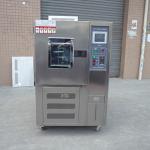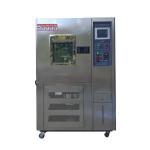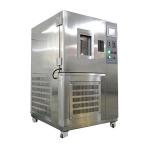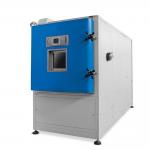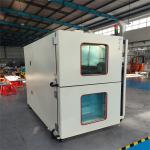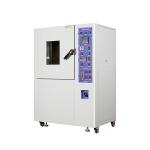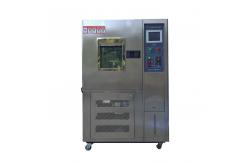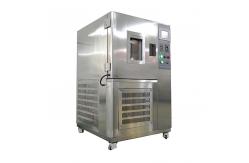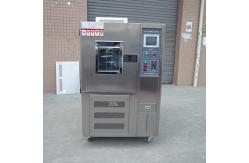In the dynamic and competitive landscape of the rubber and plastics
industry, ensuring the long-term durability and performance of
products is the cornerstone of success. The customized Ozone Aging
Test Chamber for the Rubber and Plastics Industry emerges as a
powerful and indispensable tool, designed to meet the unique
challenges and demands of this sector. This state-of-the-art test chamber is meticulously crafted to
create and control ozone-rich environments, specifically tailored
to the requirements of rubber and plastics manufacturers and
researchers. It serves as a reliable platform for evaluating the
resistance of rubber and plastic materials to the deleterious
effects of ozone exposure. By subjecting samples to a precisely
regulated ozone atmosphere, temperature, and humidity, the chamber
enables the industry to optimize material formulations, enhance
product designs, and ensure compliance with stringent quality and
safety standards. - Robust and Sealed Chamber Construction
- The chamber is constructed with a heavy-duty stainless steel frame
and walls, providing exceptional durability and resistance to
corrosion. The stainless steel not only withstands the corrosive
nature of ozone but also ensures a long service life. The chamber
is hermetically sealed using high-quality gaskets and advanced
sealing technologies, preventing any leakage of ozone and
maintaining a consistent test environment. The door is designed
with a reliable locking mechanism and a pressure-assisted seal,
ensuring a tight closure and minimizing the risk of external
contamination. The interior surfaces are smooth and easy to clean,
facilitating efficient sample handling and preventing any residue
from interfering with the test results.
- Precision Ozone Generation and Concentration Control System
- The heart of the chamber lies in its advanced ozone generation and
control system. It is capable of producing ozone with remarkable
accuracy and stability. The concentration of ozone can be precisely
adjusted within a wide range, typically from 5 parts per million
(ppm) to 1000 ppm, allowing for the simulation of various
real-world ozone levels. The system utilizes state-of-the-art ozone
generators and highly sensitive sensors. These sensors continuously
monitor the ozone concentration inside the chamber and provide
real-time feedback to the control unit. The control unit, in turn,
modulates the ozone generation rate to maintain the desired
concentration level with an accuracy of ±3% of the set value. This
level of precision is crucial for obtaining reliable and
reproducible test results.
- Accurate Temperature and Humidity Regulation
- In addition to ozone concentration, the chamber offers precise
control over temperature and humidity. The temperature can be
maintained within a range of -20°C to +80°C, with an accuracy of
±0.5°C. The humidity control range extends from 10% to 95% relative
humidity, with an accuracy of ±2% RH. Temperature and humidity play
significant roles in the ozone aging process, as they can affect
the rate of chemical reactions and the physical properties of
rubber and plastic materials. The chamber's control system ensures
that these environmental factors are held constant and within the
specified tolerances, providing a more accurate simulation of the
actual conditions that products may encounter during their
lifecycle.
- Intuitive Control Panel and Data Acquisition System
- The equipment is equipped with an intuitive control panel that
simplifies the operation and parameter setting. Operators can
easily adjust the ozone concentration, temperature, humidity, and
test duration using the user-friendly interface. The control panel
also provides real-time displays of the current values of these
parameters, as well as any alarms or warnings. The chamber is
integrated with a comprehensive data acquisition system. It records
all relevant test data, including ozone concentration profiles,
temperature and humidity histories, and any changes in the physical
properties of the test samples. The data can be stored in a
built-in memory or exported to external storage devices for further
analysis. The system also has the ability to generate detailed test
reports in various formats, such as PDF or Excel, facilitating easy
documentation and sharing of results.
- Versatile Sample Fixturing and Placement
- The interior of the chamber is designed to accommodate a wide
variety of rubber and plastic sample sizes and shapes. It can be
equipped with adjustable racks, trays, and custom-made holders to
ensure proper positioning and exposure of the test samples. The
sample fixturing is made of materials that are resistant to ozone
and do not contaminate the test environment. This flexibility
allows for the testing of different products, from small rubber
gaskets and plastic fittings to large sheets of rubber or plastic
materials. For example, rubber conveyor belts can be placed on
specialized racks to mimic their actual installation and usage
conditions, providing more accurate test results.
- Ozone Concentration Range and Accuracy
- As mentioned, the ozone concentration can be adjusted from 5 ppm to
1000 ppm, with an accuracy of ±3% of the set value. This extensive
range enables the testing of materials that may be exposed to
different ozone levels in various applications. For instance,
rubber products used in industrial settings with higher ozone
concentrations, such as in chemical plants or near electrical
equipment, can be tested at higher ozone levels, while consumer
rubber and plastic items may be evaluated at lower concentrations.
The accurate control of ozone concentration ensures that the test
results are reliable and can be used to make informed decisions
about material selection and product design.
- Temperature Range and Rate of Change
- The temperature range of -20°C to +80°C allows for the simulation
of a diverse range of climatic and operating conditions. The rate
of temperature change can be adjusted up to 5°C per minute. This
rapid temperature change capability is useful for testing the
thermal stability of rubber and plastic materials in combination
with ozone exposure. For example, in the automotive industry,
rubber components may experience sudden temperature changes while
being exposed to ozone in the atmosphere, and this chamber can
accurately replicate such conditions to assess their durability.
- Humidity Range and Rate of Change
- The humidity range of 10% to 95% RH, with a rate of change of up to
8% RH per minute, provides a comprehensive assessment of the effect
of moisture on ozone aging. High humidity can accelerate the
degradation of some rubber and plastic materials, while low
humidity may have a different impact. The ability to control
humidity precisely helps in understanding the complex interactions
between ozone, temperature, and humidity. In the plastics industry,
for example, the performance of plastic films or coatings may be
significantly affected by humidity levels, and this chamber allows
for detailed evaluation.
- Testing Volume and Payload Capacity
|
